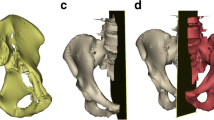Abstract
Purpose
Treating pelvic fractures remains a challenging task for orthopaedic surgeons. We aimed to evaluate the feasibility, accuracy, and effectiveness of three-dimensional (3D) printing technology and computer-assisted virtual surgery for pre-operative planning in anterior ring fractures of the pelvis. We hypothesized that using 3D printing models would reduce operation time and significantly improve the surgical outcomes of pelvic fracture repair.
Methods
We retrospectively reviewed the records of 30 patients with pelvic fractures treated by anterior pelvic fixation with locking plates (14 patients, conventional locking plate fixation; 16 patients, pre-operative virtual simulation with 3D, printing-assisted, pre-contoured, locking plate fixation). We compared operative time, instrumentation time, blood loss, and post-surgical residual displacements, as evaluated on X-ray films, among groups. Statistical analyses evaluated significant differences between the groups for each of these variables.
Results
The patients treated with the virtual simulation and 3D printing-assisted technique had significantly shorter internal fixation times, shorter surgery duration, and less blood loss (− 57 minutes, − 70 minutes, and − 274 ml, respectively; P < 0.05) than patients in the conventional surgery group. However, the post-operative radiological result was similar between groups (P > 0.05). The complication rate was less in the 3D printing group (1/16 patients) than in the conventional surgery group (3/14 patients).
Conclusion
The 3D simulation and printing technique is an effective and reliable method for treating anterior pelvic ring fractures. With precise pre-operative planning and accurate execution of the procedures, this time-saving approach can provide a more personalized treatment plan, allowing for a safer orthopaedic surgery.





Similar content being viewed by others
References
Tile M (1988) Pelvic ring fractures: should they be fixed? J Bone Joint Surg Br 70:1–12
Matta JM (1996) Indications for anterior fixation of pelvic fractures. Clin Orthop Relat Res 329:88–96
Tile M (2005) Fractures of the acetabulum. In: Schatzker J, Tile M (eds) The rationale of operative fracture care, 3rd edn. Springer, New York, pp 291–340
Fuller SM, Butz DR, Vevang CB, Makhlouf MV (2014) Application of 3-dimensional printing in hand surgery for production of a novel bone reduction clamp. J Hand Surg 39(9):1840–1845
Rankin TM, Giovinco NA, Cucher DJ, Watts G, Hurwitz B, Armstrong DG (2014) 3D printing surgical instruments: are we there yet? J Surg Res 189:193–197
Wu XB, Wang JQ, Zhao CP, Sun X, Shi Y, Zhang ZA, Li YN, Wang MY (2015) Printed three-dimensional anatomic templates for virtual preoperative planning before reconstruction of old pelvic injuries: initial results. Chin Med J 128:477–482
Rhee YG, Cho NS, Cha SW, Moon SC, Hwang SP (2014) Indirect reduction technique in proximal humeral fractures stabilized by locking plates. Clin Should Elbow 17:2–9
Tam MD, Laycock SD, Bell D, Chojnowski A (2012) 3-D printout of a DICOM file to aid surgical planning in a 6-year-old patient with a large scapular osteochondroma complicating congenital diaphyseal aclasia. J Radiol Case Rep 6:31–37
Munjal S, Leopold SS, Kornreich D, Shott S, Finn HA (2000) CT-generated 3-dimensional models for complex acetabular reconstruction. J Arthroplast 15:644–653
Landi A, Mancarella C, Gregori F, Delfini R (2015) Spinal neuronavigation and 3D-printed tubular guide for pedicle screw placement: a really new tool to improve safety and accuracy of the surgical technique? J Spine 4:e118. https://doi.org/10.4172/21657939.1000e118
Schwartz A, Money K, Spangehl M, Hattrup S, Claridge RJ, Beauchamp C (2015) Office-based rapid prototyping in orthopedic surgery: a novel planning technique and review of the literature. Am J Orthop (Belle Mead NJ) 44:19–25
Cimerman M, Kristan A (2007) Preoperative planning in pelvic and acetabular surgery: the value of advanced computerised planning modules. Injury 38:442–449
Shen F, Chen B, Guo Q, Qi Y, Shen Y (2013) Augmented reality patient specific reconstruction plate design for pelvic and acetabular fracture surgery. Int J Comput Assist Radiol Surg 8:169–179
Rose AS, Webster CE, Harrysson OL, Formeister EJ, Rawal RB, Iseli CE (2015) Preoperative simulation of pediatric mastoid surgery with 3D-printed temporal bone models. Int J Pediatr Otorhinolaryngol 79:740–744
Tile M, Helfet D, Kellam J (2003) Fractures of pelvis and acetabulum. Lippincott Williams and Wilkins, Philadelphia
Bagaria V, Deshpande S, Rasalkar DD, Kuthe A, Paunipagar BK (2011) Use of rapid prototyping and three-dimensional reconstruction modeling in the management of complex fractures. Eur J Radiol 80:814–820
O’Shea K, Quinlan JF, Waheed K, Brady OH (2006) The usefulness of computed tomography following open reduction and internal fixation of acetabular fractures. J Orthop Surg (Hong Kong) 14:127–132
Lindahl J, Hirvensalo E, Böstman O, Santavirta S (1999) Failure of reduction with an external fixator in the management of injuries of the pelvic ring. Long-term evaluation of 110 patients. J Bone Joint Surg Br 81:955–962
Author information
Authors and Affiliations
Corresponding author
Ethics declarations
Conflict of interest
The authors declare they have no conflicts of interest.
Research involving human participants and/or animals
Ethical approval
The study was approved by the National Defense Medical Center Institutional Review Board. All procedures were in accordance with the 1964 Helsinki declaration and its later amendments or comparable ethical standards.
Informed consent
Informed consent was obtained from all individual participants included in the study.
Rights and permissions
About this article
Cite this article
Hung, CC., Li, YT., Chou, YC. et al. Conventional plate fixation method versus pre-operative virtual simulation and three-dimensional printing-assisted contoured plate fixation method in the treatment of anterior pelvic ring fracture. International Orthopaedics (SICOT) 43, 425–431 (2019). https://doi.org/10.1007/s00264-018-3963-2
Received:
Accepted:
Published:
Issue Date:
DOI: https://doi.org/10.1007/s00264-018-3963-2




